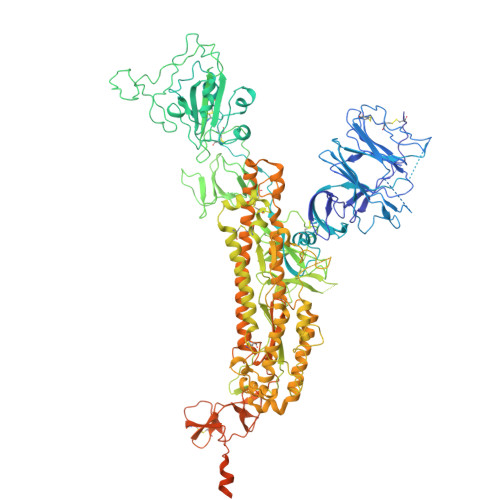Optimization of VE607 to generate analogs with improved neutralization activities against SARS-CoV-2 variants.
Ding, S., Yang, D., Ullah, I., Niu, L., Unger, M., Diaz-Salinas, M.A., Chandravanshi, M., Zhou, F., Beaudoin-Bussieres, G., Benlarbi, M., Tolbert, W.D., Yoon, K.W., Xu, R., Laroche, G., Gaudette, F., Morton, A.J., Lang, Z.C., Son, A., Abrams, C., Cote, M., Smith 3rd, A.B., Huang, R.K., Matthies, D., Munro, J.B., Pazgier, M., Uchil, P.D., Finzi, A.(2025) J Virol : e0103425-e0103425
- PubMed: 41081594
- DOI: https://doi.org/10.1128/jvi.01034-25
- PubMed Abstract:
Severe acute respiratory syndrome coronavirus 2 (SARS-CoV-2) infection remains a threat to human health, particularly among immunocompromised and elderly individuals, given their heightened vulnerability to coronavirus disease 2019 (COVID-19)-associated morbidity and mortality. Recently, omicron subvariants such as KP.3.1.1 and XEC have emerged with an enhanced ability to evade humoral immunity. The development of new strategies against these variants of concern remains an intense area of research. The small molecule VE607 is an entry inhibitor that targets the Spike glycoprotein and delays virus spread in vivo . To improve the potency of this new class of SARS-CoV-2 entry inhibitors, we generated and characterized VE607 analogs and identified candidates with enhanced activity against variants, including KP.3.1.1 and XEC. Promising analogs exhibited higher inhibitory potency than the original compound and stabilized the receptor-binding domain in its "up" conformation. Among these, DY-III-281 also reduced viral burden and delayed death in SARS-CoV-2-challenged K18-hACE2 transgenic mice. Furthermore, combining DY-III-281 with a non-neutralizing antibody engineered for Fc-enhanced functions exhibited an additive effect in reducing SARS-CoV-2-induced disease burden in mice. Our findings support the continued development of small-molecule entry inhibitors, alone or in combination with antibody-based therapies, as a promising strategy to counteract emerging SARS-CoV-2 variants. Mutations in the Spike glycoprotein drive viral evolution and confer resistance to current vaccines and some therapeutic interventions against severe acute respiratory syndrome coronavirus 2 (SARS-CoV-2). Here, we report new analogs of the SARS-CoV-2 small-molecule entry inhibitor VE607. These analogs exhibited improved potency against emerging SARS-CoV-2 variants, including KP.3.1.1 and XEC. One analog, DY-III-281, delayed viral replication in SARS-CoV-2 WA1 -challenged K18-hACE2 transgenic mice, suggesting that small-molecule compounds targeting viral entry might be useful in fighting evolving SARS-CoV-2 variants.
- Centre de Recherche du CHUM, Montreal, Québec, Canada.
Organizational Affiliation:



















